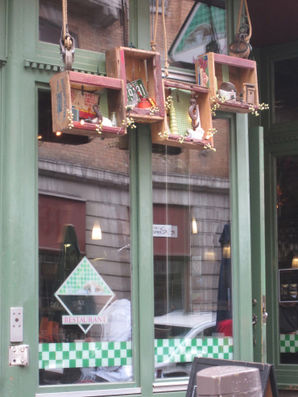
QUEBEC CITY DAY 4
May 30th 2015
Until this trip I hadn’t spent much time looking into my French ancestry. It turns out Raymond Legris (my maternal grandfather) was the 10th generation descended from Guillame Legris of Brittany. Three of his sons, including our ancestor Adrien, emigrated to New France (Quebec) in 1680. Quebec City was founded by Samuel de Champlaign in 1608 and reached a population of 500 by 1663. When the Legris brothers arrived it had grown to 1300, partially due to the promise of wealth from the fur trade …and partially due to the fact that the government, in an effort to increase population, awarded a sum equal to the value of six cows for every child in a family. (That subsidy only lasted ten years as French Catholic families exceeded government estimates and it could no longer fulfill the contracts).
I spent three hours at the Musée de la civilisation on Saturday. Half of the first floor is taken up by an exhibit on the history of animation in film in Canada. Following the history of projections from the early 1800s through computer animation was fascinating – highly recommend a visit. “The Peoples of Quebec City” exhibit was a study in curation and museum design, what could have been boring and dry actually kept an entire tour of middle school students engaged.
While visiting the “Magic in Ancient Egypt” exhibit at Musee de la civilisation I was struck by how many parallels there are between Christianity and the traditions of ancient Egypt. Rather than a god for a particular concern, Catholic traditions have saints. Mummification and death rituals are echoed in our own Western funeral traditions. Temples have been replaced by cathedrals but the aspect of community ritual remains.
From there it was on to Musee de la Place Royal. It’s in the heart of Quartier Petit Champlain and is a strange little museum focused on the history of that neighborhood. Artifacts are from the homes, warehouses, and businesses that once stood in the surrounding blocks.
My evening field trip included a visit to Ecole de Cirque, the Quebec City school of circus arts, to see their spring youth performance. Housed in a decommissioned church, the school transformed the main floor into a highly flexible practice/performance space. Many of the pieces featured performers of mixed ages, body types, and abilities. Both boys and girls were trained in every aspect from juggling to the silks. Young girls served as bases while boys “flew” and vice versa. The crew who set up and rigged the equipment and also provided comic relief between each piece was comprised of both students and coaches. The emphasis was on community, artistry, and athleticism. Stars were given showcase pieces but they also performed with younger athletes and those who may not have had their level of skill. It was the embodiment of what most youth organizations tout as their mission …and a far cry from what most of them actually do












